Essentially, a Recovery Drive stores a copy of your Windows 11/10 environment without your personal files and desktop applications on another source, such as a DVD or USB drive. So in the event your Windows 11/10 goes south, you can restore it from that drive. In this post, we will illustrate how you can use a recovery drive to restore a Windows 11/10 computer.
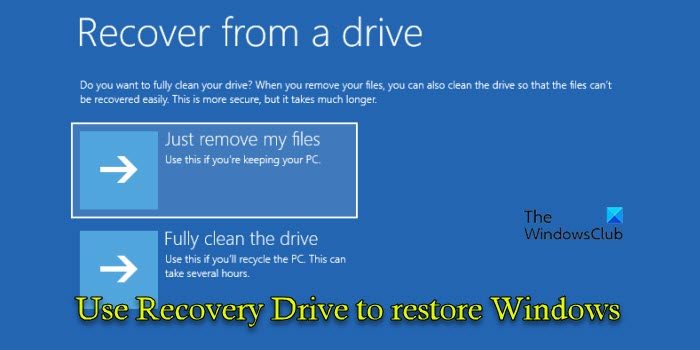
Use Recovery Drive to restore Windows 11/10
You have earlier created a recovery drive for your Windows PC and at a certain time, your Windows installation is so damaged that it’s unable to load or repair itself, you can follow the 7-step process in the order outlined below to successfully restore your Windows 11/10 installation using the recovery USB drive or DVD media.
- Boot the PC using the Recovery Drive
- Select a Language
- Recover from a drive
- Remove Files
- Recover Windows
- Finalize recovery
- Set up Windows
Let’s take a look at the brief description as it concerns each of the steps.
Note: Ensure you have backed up all important files and data, as this process will erase everything on your system drive.
1] Boot the PC using the Recovery Drive
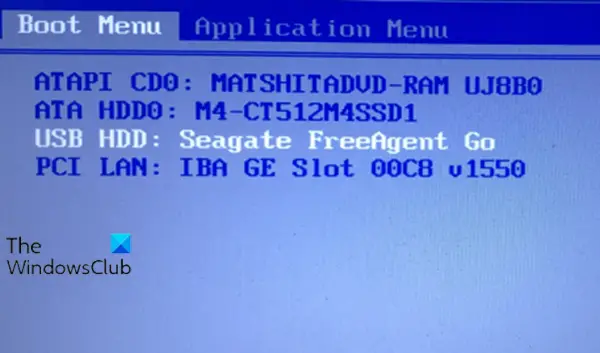
Connect the USB drive or insert the DVD into your computer and restart it. As your computer restarts, press the appropriate key (F2, F12, Esc, Del, etc.) to enter the BIOS/UEFI settings and boot from the USB drive or DVD instead of your hard drive. Save the changes and exit BIOS/UEFI. Your computer will now boot from the Recovery Drive.
2] Select a Language

Once the computer boots from the Recovery Drive, you’ll enter the Windows Recovery Environment (WinRE). At the keyboard layout screen, select the keyboard for your language or country and press Enter.
Related: Recovery Drive is full! How to free up space on Recovery Drive in Windows?
3] Recover from a drive
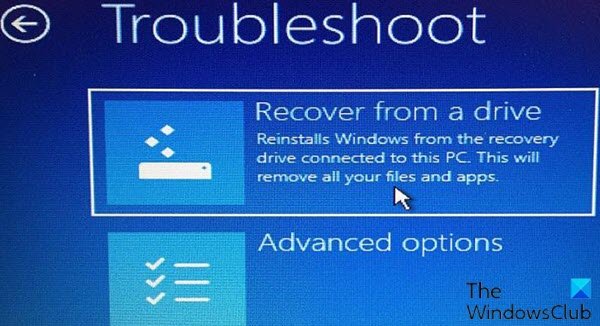
On the next screen, select the Troubleshoot option. In the Troubleshoot menu, choose Recover from a drive to instruct the computer to take the version of Windows on your recovery drive. As a reminder, this means all your files and apps will be removed after the operating system is reinstalled.
4] Remove Files
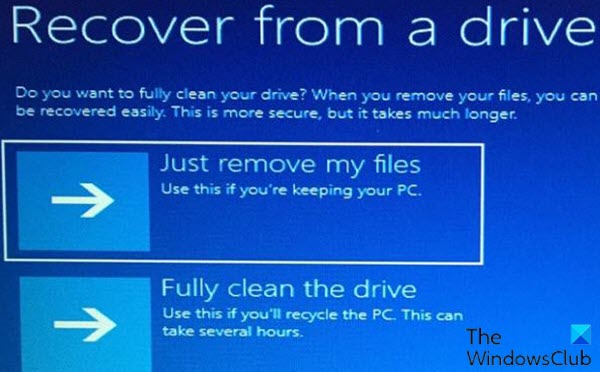
You will see two options:
- Just remove my files: This option will remove your files but keep your system ready for immediate use. It’s faster but less secure if you plan to keep using the PC.
- Fully clean the drive: This option will completely clean the drive, which takes more time but ensures all data is thoroughly erased. Choose this if you’re planning to recycle the computer.
In this demonstration, we are clicking Just remove my files.
5] Recover Windows
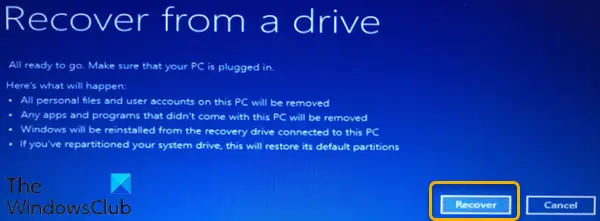
The final step is to click Recover. The recovery process will begin. This may take some time, depending on the size of your drive and the option chosen.
The computer will warn you one more time that all personal files will be deleted and any apps that did not come with the OS will be removed. Furthermore, if you partitioned your hard drive, this will restore it to its original state, which means you’ll have to set up the partition again.
6] Finalize recovery
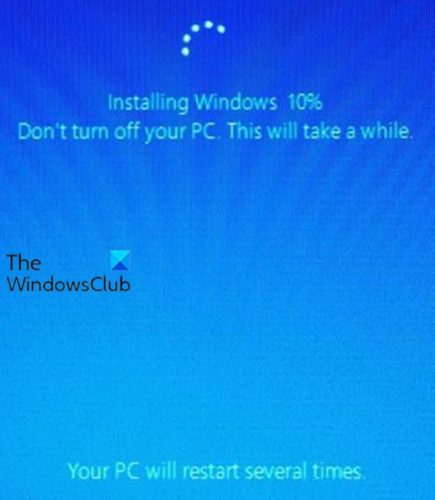
At this penultimate step, Windows will then show that it’s recovering your PC. Your computer will restart several times during the process. When finished, Windows 11/10 will be officially reinstalled.
7] Set up Windows 11/10
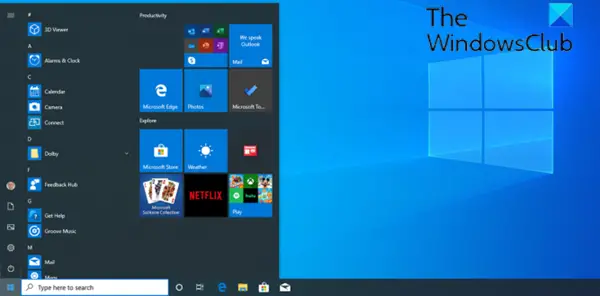
At this last step, Windows 11/10 then takes you through the (OOBE) setup process and applies any updates.
Follow the on-screen instructions to set up Windows. This will include creating a user account, choosing your region, and configuring your network settings.
After the setup is finished, you can sign in to Windows 11/10. You can now restore your personal files if you’ve previously backed them up. You’ll also need to reinstall your applications as well.
And that’s your 7-step process to using a recovery drive to restore Windows 11/10!
Read: How to recover files when Windows won’t boot.
Does Windows 11 recovery drive work with Windows 10?
Using a Windows 11 Recovery Drive on a Windows 10 computer can lead to compatibility issues since a recovery drive contains system files that are specific to the version of Windows it was created on. Also, Windows 11 and Windows 10 might have different boot configurations and drivers, and mixing these can cause boot failures or improper system restoration. So create a separate Recovery Drive for each operating system you plan to restore.
How to restore Windows 11 to Windows 10?
If it’s been less than 10 days since you upgraded from Windows 10 to Windows 11 (and if you haven’t deleted the ‘Windows.old’ folder), you can use the built-in rollback feature to go back to Windows 10. Open the Settings app and go to System > Recovery. Click the Go back button under the ‘Recovery options’ section. If it’s been more than 10 days but you have a system image backup of your Windows 10 installation, you can use it to downgrade your OS. Otherwise, a clean will be the most reliable way to revert to Windows 10.
Read Next: Create Surface Book and Surface Pro Recovery Drive.
Leave a Reply